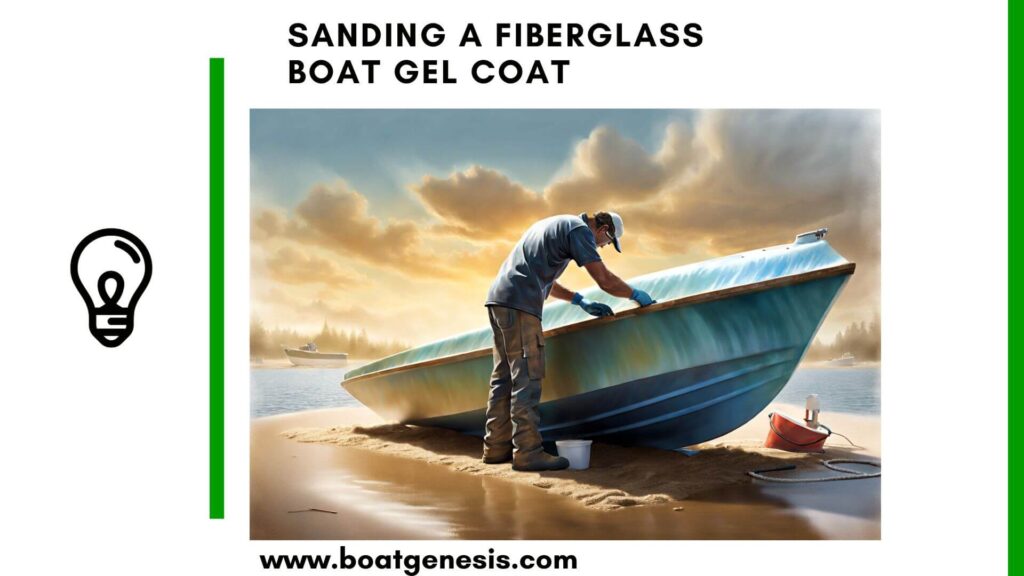A smooth, properly prepared fiberglass hull is crucial for a boat’s performance and longevity. Sanding is one of the most important steps for achieving an optimal repair, finish before painting or varnishing.
In this article, we’ll walk through the step-by-step process of sanding a fiberglass boat gel coat.
4 Steps for Sanding a Fiberglass Boat Gel Coat
1. Assessing the Surface
Before sanding, thoroughly clean the fiberglass and allow it to fully dry. Carefully inspect for any flaws, gouges, or uneven areas.
Determine the smoothness required for your project finish. Identify which grit sandpaper is needed to remedy imperfections while achieving the necessary smoothness.
2. Selecting Sandpaper

For fiberglass sanding, aluminium oxide and silicon carbide papers are best. The commonly used grit sizes are 80, 100, and 120.
Start with more coarse 80 or 100 grit to remove heavier oxidation or surface defects. Then use progressively finer 120 and 220 grits to smooth the area for finishes and paint adhesion.
Always use high-quality sandpaper that resists clogging.
3. Sanding Technique
When sanding gel coat on a fiberglass boat, always use straight even strokes in a consistent direction. Apply moderate pressure allowing the abrasive paper to do the work. Over-pressuring causes uneven scratches requiring extra sanding.
Frequently switch stroke direction to ensure level sanding.
If using power tools, use variable speed to control the abrasion rate. Move slowly over the gel coating to avoid excess material removal. Carefully hand sand hardware, logos, stripes, and tight spaces.
4. Process Checkpoints
Frequently stop and wipe clean sanded areas to inspect smoothness and verify all imperfections are removed.
Check for uneven spots requiring additional sanding to prevent visibility under the finish.
Once the entire surface meets smoothness standards, use a tack cloth to remove all dust before progressing to polishing compounds or finishes.
Wet Sanding a Fiberglass Boat
When refinishing a fiberglass boat, wet sanding the exterior gel coat layer is key for a flawless glossy finish.
Wet sanding uses water to provide lubrication during the sanding process to achieve an ultra-smooth surface finish. As grit particles abrade the surface, the water floats away the sanded material keeping scratching to a minimum.
This allows progressively finer grits to be used without causing deeper visible scratches or swirl marks.
The key reasons to wet sand fiberglass gel coat are:
- Create a smooth surface for gloss clarity
- Use finer grit papers more safely
- Reduce scratches and swirl marks
- Eliminate airborne fiberglass dust
- Enable better control through the process
Below are the steps for wet sanding fiberglass boat gel coat.
Note that the gel coat is only 5-25 mils thick according to Jamestown Distributors, so careful process control is imperative.
Preparing to Wet Sand
Fill cracks or flaws in the gelcoat using recommended repair compounds before sanding. Thoroughly wash the area with a boat soap solution to remove wax, grease and surface contaminants.
Start by dry sanding the gelcoat to remove heavy oxidation and surface defects using 600-800 grit.
Wet Sanding Process
Begin wet sanding by keeping the area wet with clean water while sanding to provide constant lubrication.
Use a foam sanding block to back up your paper to ensure an even scratch pattern.
Start with 1000 grit wet/dry making straight passes until achieving a uniform scratch pattern without visible unevenness or swirl marks.
Wipe frequently and change water often to prevent scratching from built-up residue.
Finishing Steps
Progress through finer grits up to 2000 grit repeating the prior steps until obtaining a smooth, glass-like finish.
Exercise caution to avoid excess pressure or over sanding which can cut through the gelcoat. Complete by thoroughly rinsing and then immediately drying the area.
Carefully inspect under bright light for any remaining imperfections.
FAQ
Here are answers to some frequently asked questions about sanding fiberglass boat hulls:
Random orbital sanders allow good control and minimize swirl marks. Models with variable speeds under 6,000 RPM are ideal for gelcoat.
Yes, wet sanding helps reduce airborne dust. However, don’t let water pool as this can impact results.
Applying too much pressure and not moving evenly can create visible swirls. Ensure you sand methodically using moderate pressure.
routinely stop and wipe away all dust to visually inspect for defined scratch marks. Run your hand over the area as well feeling for defects.
Use extra care when sanding near or below the water line where the gelcoat is thinner and more susceptible to issues with excessive material removal.
Conclusion
With the right methods and grade sandpapers, preparing a fiberglass boat hull for the optimal painted or varnished finish is straightforward.
Carefully assess the surface progressing through the essential grits, then properly clean before applying finishes.
Follow these best practices for achieving that smooth ‘factory’ look to your boat’s valuable fiberglass asset.


